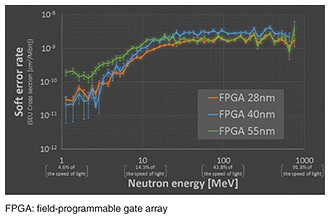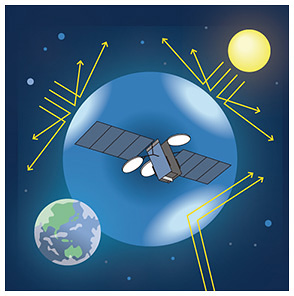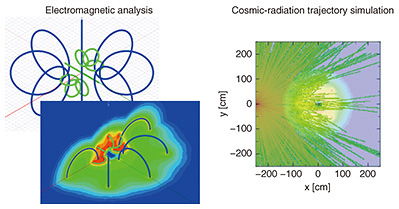 |
|||||||||||
|
|
|||||||||||
|
Feature Articles: Activities toward Zero Environmental Impact and Environmental Adaptation to Build a Resilient Society Vol. 21, No. 2, pp. 39–44, Feb. 2023. https://doi.org/10.53829/ntr202302fa5 Proactive Environmental Adaptation Technology to Ensure Safe and Secure Living Conditions Even under Extreme Natural PhenomenaAbstractNTT Space Environment and Energy Laboratories is developing technologies for humans to proactively adapt to extreme natural phenomena so they can live safely and securely on Earth and in space. We have been developing technologies to protect communication equipment from lightning strikes and cosmic rays. This article introduces lightning control and charging technology and cosmic-ray barrier technology that builds on the technologies we have developed as well as brings about fundamental changes to conventional countermeasures. Keywords: lightning, drone, cosmic ray 1. IntroductionNTT is driving innovative research and development to create a smart world, a society in which everyone can lead a prosperous life. In such a society, the failure of a single device can have a flow-on effect and significantly affect systems that people depend on. Therefore, it has become more important than ever to keep infrastructures and critical systems running stably even in the event of disasters and other phenomena. Recent technological innovations have given rise to initiatives involving the use of drones and satellite communications to ensure uninterrupted services and early recovery of communications in the event of disasters. NTT Space Environment and Energy Laboratories is conducting research and development to enable humans to lead safe and secure lives under various potentially disruptive natural phenomena with a focus on lightning and cosmic rays. 2. Lightning control and charging technologyLightning strikes are one of the natural phenomena that inflict extensive damage on key infrastructure. The mechanisms of lightning strikes and technologies to prevent lightning damage have been studied for hundreds of years. Despite the fact that various lightning-strike countermeasures have been incorporated into critical infrastructures, lightning damage has still not been completely eliminated. The cost of this damage is estimated to exceed 100 billion yen annually in Japan alone. Preventing damage from lightning strikes is a major challenge in creating a smart world. To address this issue, we have made major upgrades to the technologies we have designed to protect communication facilities from lightning. We are studying technology to use drones to capture lightning bolts, guiding them to locations where there are no people or infrastructure facilities, and inducing strikes to occur there. We are also developing technology to store and use the energy of induced lightning strikes (Fig. 1).
The key device to a system consisting of the above technologies is a lightning-resistant drone, a robust drone that does not fail even when struck by lightning (Fig. 2). The drone is encased in a metal shield called a Faraday cage, which protects the drone from lightning currents and the magnetic fields generated by them. Our experiments using an artificial lightning generator have confirmed that the drone can withstand a lightning strike of 120 kA, which is five times greater than average lightning currents. In addition to being resistant to lightning, a Faraday cage must be light enough so that the drone can fly stably even in strong winds. We have conducted various simulations and experiments to develop a Faraday cage that largely satisfies the requirements for protection balanced with lightness.
To demonstrate that this lightning-resistant drone can withstand natural lightning strikes, in December 2021 we began the world’s first experiment of intentionally inducing lightning strikes using a drone. The experiment was conducted in collaboration with the Faculty of Engineering, Gifu University off the coast of Uchinada Town, Ishikawa Prefecture, where thunderclouds frequently form in winter (Fig. 3). The way to induce lightning strikes is as follows; a drone is flown under thunderclouds. When the electric field generated by the thunderclouds increase, a conductive wire is dropped and stretched from the drone. This must rapidly boost the electric field near the lower end of the wire, resulting in an electric spark between the lower end of the wire and sea surface (Fig. 3, (1)). This spark makes the wire grounded electrically, which in turn sharply increases the electric field above the drone. This will generate a spark from the top of the drone toward the cloud (Fig. 3, (2)), which is assumed to result in a lightning strike.
Unfortunately, a lightning strike was not induced in the winter FY2021 experiment, but it did confirm that a spark occurred between the lower end of the wire and sea surface, which was part of the lightning-induction process, and that the developed lightning-resistant drone was able to fly stably in strong winds exceeding 20 m/s under thunderclouds (Fig. 4). Building on the data obtained in FY2021, we will improve the experimental system and conduct another experiment in the winter of FY2022, aiming at the successful induction of lightning strikes.
In parallel with these studies, we are conducting joint research with Hokkaido University on lightning-strike prediction technology, which is key to improving the success rate of lightning induction. Applying the university’s meteorological lightning model [1], we simulate the weather conditions several days ahead and the associated generation and diffusion of electric charge in clouds. The aim is to develop technology for accurately predicting the areas where lightning strikes occur as well as the number of lightning strikes. We are also studying how to use lightning energy for charging and other purposes. Since lightning bolts generate large currents of up to several hundred kiloamperes that flow in as short a period of time as several milliseconds, it is difficult to charge them to batteries directly. To solve this problem, we are investigating an innovative method for efficiently storing the electrical energy of lightning bolts by converting it into kinetic energy, pressure energy, or other forms of energy. We are making steady progress toward controlling lightning and using it for charging. 3. Cosmic-ray barrier technologyHumans have been exploring space, from launching space infrastructures, such as GPS (Global Positioning System) satellites and communication satellites, to planning space travel. The entry into space is becoming key to the future advancement of mankind. Efforts to develop space technology have matured and are shifting from the traditional efforts led by governments (Old Space) to initiatives led by the private sector (New Space). NTT is aiming at global deployment of services based on the space datacenter [2], which will use space to build a solid social infrastructure for a smart world. Although space development has been an attractive area for the advancement of modern society, the utilization of space involves many difficult issues. One is strong cosmic rays, which are unique to the space environment. Our solar system’s Sun and other stars in the galaxy emit a constant stream of cosmic rays. This radiation has adverse effects on the human body and electronic devices. In addition, the intensity of solar activity, which waxes and wanes in an 11-year cycle, poses grave threats to the health of our modern electronics-intensive social infrastructure. NTT has established the world’s first method [3] of measuring the soft-error rate at different levels of cosmic-ray-generated neutron energy, which affects electronic devices on the ground (Fig. 5).
NTT has also been instrumental in achieving the international standardization of countermeasures [4] and commercialization of testing services [5]. By applying these achievements to space, we are developing a cosmic-ray barrier that will support the use of space by humans and facilitate the construction of a robust social infrastructure (Fig. 6).
Cosmic rays consist of charged particles with protons as the main constituent. The trajectory of a charged particle is affected by the magnetic field. On Earth, its geomagnetic field acts as a barrier to cosmic rays. By applying this principle and surrounding satellites, space stations, and lunar bases with such a barrier, it is possible to reduce the risk posed by cosmic radiation. We are currently verifying the effect of such a measure by calculating the degree to which a generated magnetic field changes the trajectory of cosmic radiation using a combination of electromagnetic field analysis and particle transport simulations (Fig. 7).
Since cosmic rays have various types of kinetic energy, it is important to understand the effect of the kinetic energy on the trajectories of charged particles and extent of the impact of cosmic rays. We have succeeded in the hitherto difficult measurement of the impact of the neutron energy generated by cosmic rays on semiconductors. We believe that measuring the impact of the energy of other types of cosmic rays, such as protons and heavy particles, will enable us to evaluate the impact of cosmic radiation more precisely. We are also carrying out repeated experiments using an accelerator that can artificially generate cosmic rays and simulations to develop an effective cosmic-ray barrier. These research efforts will enable us to construct a highly reliable space datacenter and enable people to stay in space for an extended period, making the dream of manned planetary exploration and the construction of a lunar base a reality. In addition, the data on the impact of cosmic-ray neutrons on semiconductors can be used in designing neutron shielding materials and taking material-level countermeasures, making it possible to protect social infrastructures on the ground and electronic devices in accelerator facilities used for medical treatment and research. 4. ConclusionThis article introduced lightning control and charging technology and cosmic-ray barrier technology. The former aims to eliminate the damage caused by lightning strikes, which are occurring constantly around the world, and ultimately to eliminate lightning strikes by absorbing the energy of thunderclouds. The latter aims to eliminate the impact of cosmic radiation and actualize a future world in which humans can live and work freely and safely in space. Going forward, we will study proactive responses to natural phenomena other than lightning and cosmic rays. References
|
|||||||||||























